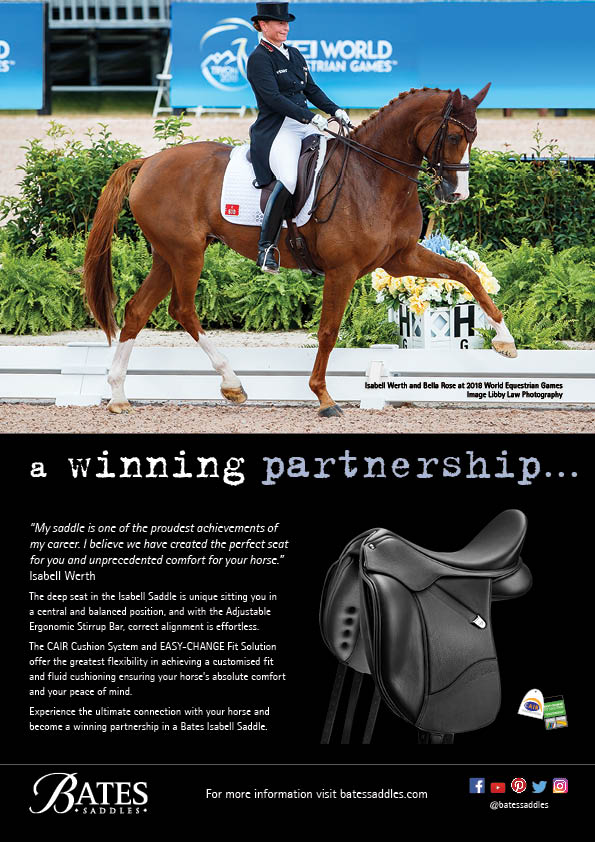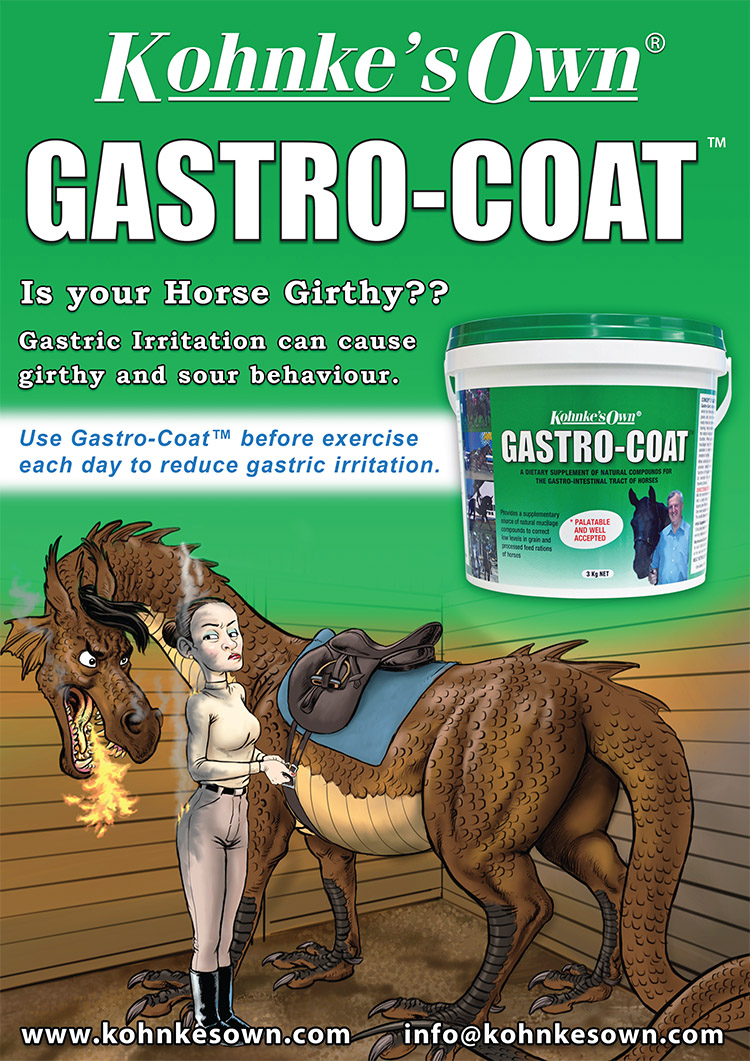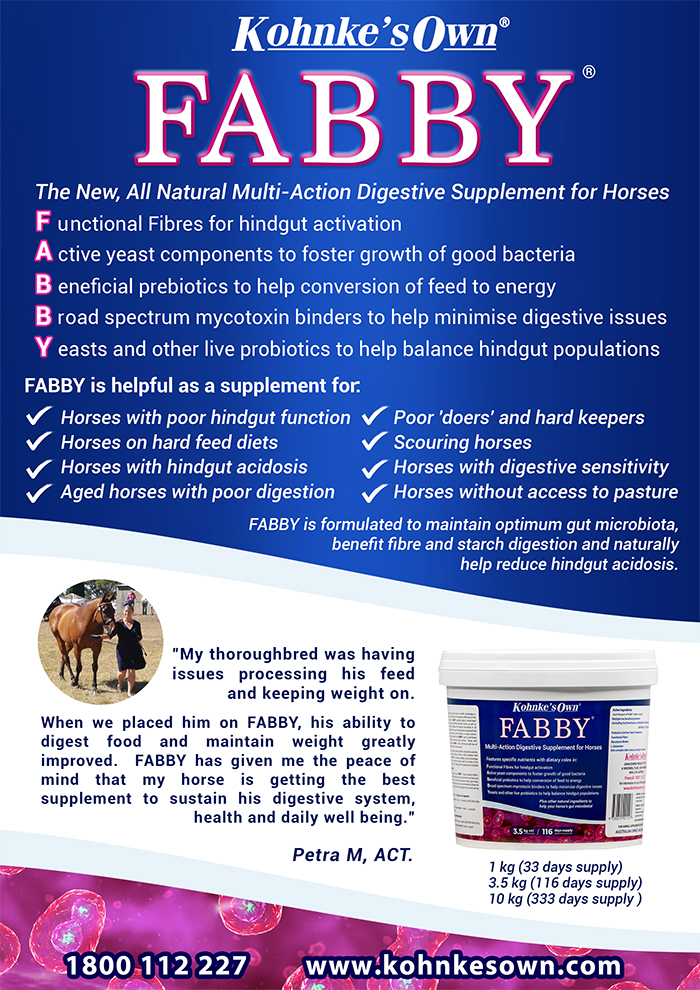
Christopher Hector wrote the story, Roslyn Neave and the Team took the photos
It was the last story in a whirl-wind tour of Germany, seven days, twelve interviews, now back to a familiar spot – the very attractive indoor arena outside Dusseldorf , where I interviewed Jean Bemelmans back in 2010. I have done many stories with Jean, I know well, he is a genius trainer, but is there a new story to tell?
Yes, and how! And it even has a truly international flavor.
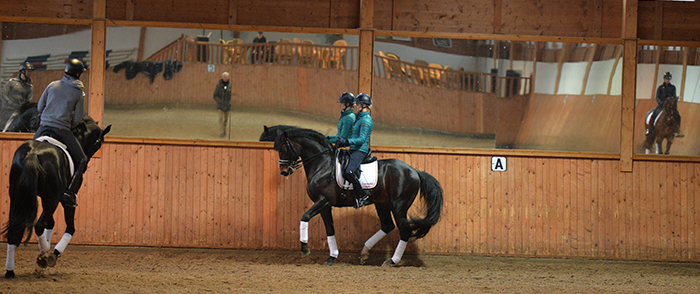
Jean and the team at work, Ashlea and the Polish stallion, Arriba in piaffe
Ashlea Day was an effervescent teenager when she joined the Horse Magazine WEG tour to Aachen, since then she represented Australia in the Young Rider World Cup Freestyle in Frankfurt, before disappearing off my radar. Now she has re-appeared, working with Alex Brenninkmeijer and Borja Carrascosa at C & B dressage, with Jean Bemelmans, and based at the Gut Auric training facility that was previously Jean’s base for several years. Alex is kind of the organizational wizard, who also likes to ride, Ashlea is the groom who became a rider and social media whiz, and Borja is the star, the one who has already ridden at the highest level, Europeans, Caen WEG, reserve at Rio, and is looking for a spot in the Spanish team at the Tryon WEG later this year.
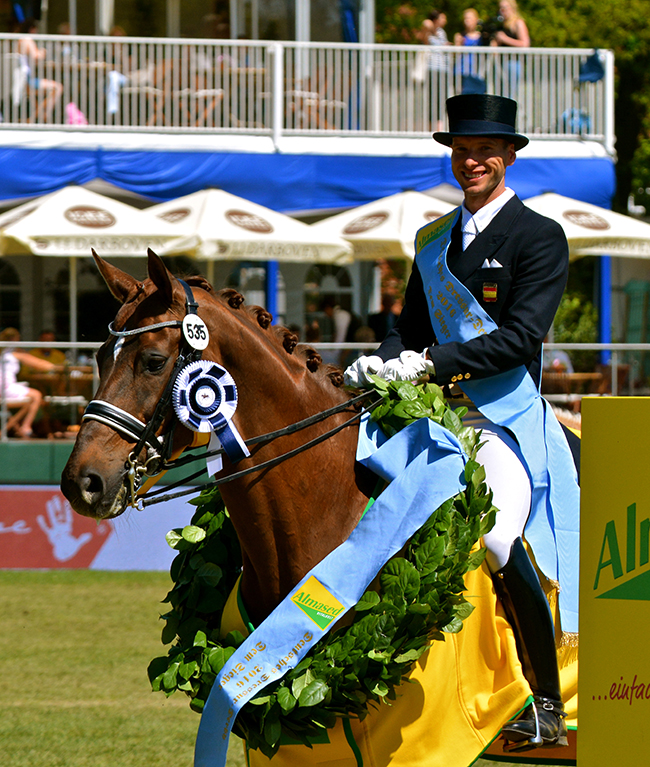
Borja has a win during his time at Hof Kasselmann
The team bubbles with excitement and it has rubbed off on Jean (to tell the truth he always was pretty bubbly) and the buzz around the arena is electric.
Jean Bemelmans is also a philosopher, always ready to put the latest moves in his life in the context of the ongoing journey.
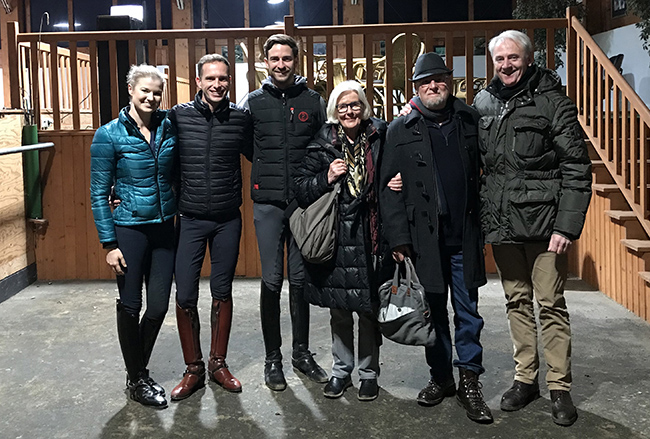
So this is the new phase of your life – a new phase but back where we visited you some years ago…
(You should be hearing laughter when Jean answers most questions)
“Everything is the same, but very different.”
It’s an exciting new team…
“Yes, I think it is a good mix between my age and their age. For me it’s fine to be with young people every day, it keeps me also younger and it keeps me going because I have to run to keep up with them.”
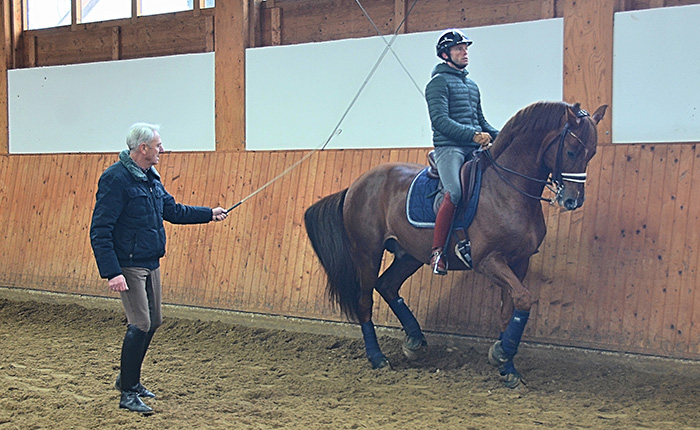
Jean helps Borja…
And Jean has plans not just to keep up with them, but to turn Borja into his first Olympic Gold Medalist…
“If we don’t have ambitions to be the best of the best, then we don’t get up in the morning. This is our goal, but it is not just a gold medal, we like to ride and we have such nice horses, and if these horses go well, then they will be successful – nobody can stop it. Some people, they complain at times about the judges, and I say, don’t complain, look to the one who gives you less points, there is a reason for this. Look at your results sheet, and try to get better, because at the end of the day, the good ones are in front. You cannot stop it, you can have all the world against you, if you are good and you do a super performance, you win.”
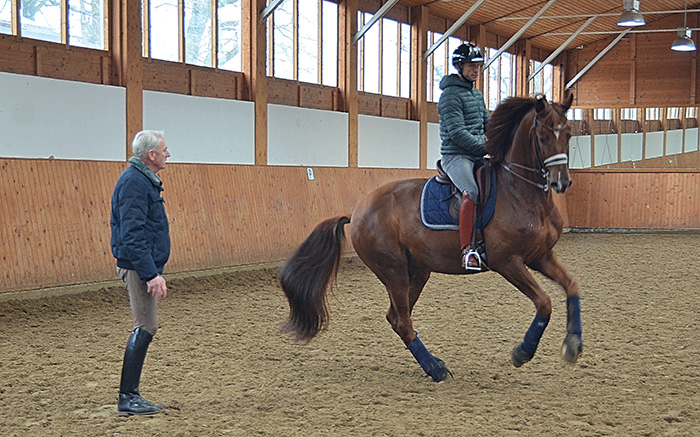
You think Borja has the talent to go all the way?
“I believe very strongly he has all the talent to do this, but it is not only him, we have so many nice people in the stables, so many nice horses. We just do our job. Every day, we work with the young horses, from the easy exercises to the difficult, the horse has to learn something. The day that the horse has learned something, we go back to the easy things, and make him happy again. If he has to learn every day, then he is fed up, there have to be some days when he says I know everything, I am ready, so now I make my body strong. This is the gymnastic, this is the basis. If you go to the Olympics, all the horses can do Grand Prix, but who wins? Who makes it correct, without mistakes, and if you have a talented horse with expression, you win, but first it has to be correct and without mistakes.”
next Jean talks more about asking too much of the horse
You were saying that you think the problem is that the riders get to Grand Prix and then they ask for more and more and then the horse gives up…
“For me, it is very important that you accept a certain talent in your horse and you don’t ‘over-talent’ him. There is always something that can be better and better, but at a certain point, is it worth pushing? I remember very well one day working with Rafael Soto and Invasor. When I rode Invasor, I could make him trot very nicely, but Rafael could not do it. I wasn’t happy with Rafael and we had a little fight, and at the end, Rafael said ‘Jean let Invasor and I stay friends, I know you can make him trot, I cannot do it, but I can do very well passage / piaffe, why should we kill him every day for something I cannot do? Let’s live with the good things.’ And I think that’s how it should be in life, it was a good learning experience for me. With the horses I think that it is super important that you analyse a horse and see what he needs, then you can do your job and you make the horse as good as he can be. But NOT MORE than he can be. If you ask for more than he can be, he gets desperate.”
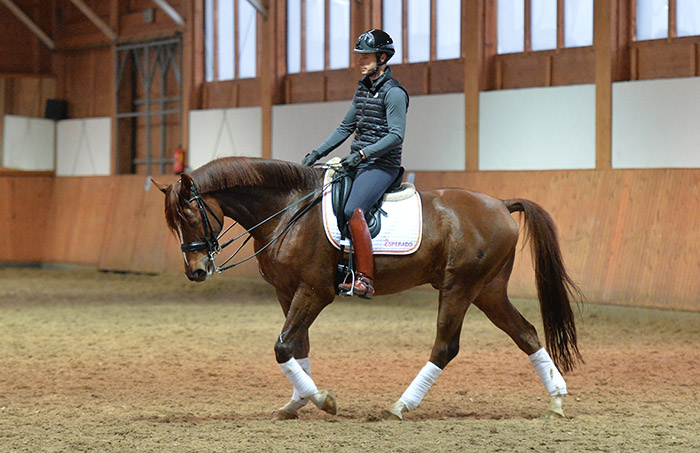
And always you have to go back to basics and let your horse stretch…
“At the end, what is a rider? The rider is the best veterinarian because if you ride your horse very well every day, then the horse doesn’t need a vet. It is super important that you are a good rider and this is something that is not new, it’s old.”
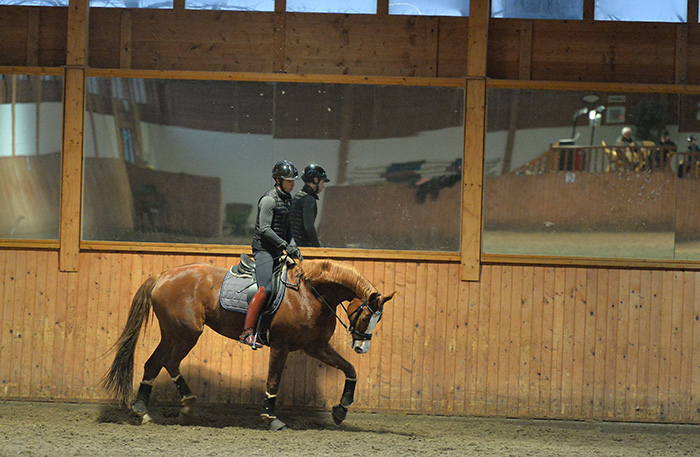
“Nowadays, I find there are many riders who think about their horses, but they are not thinking about themselves. Is the rider prepared? Are they doing sport themselves? Are they sitting independent of the reins? Are they doing sitting exercises every day? Can they use their body – tense it, flex it, loosen it – can they work with their body. That is something that is maybe forgotten. We sit on the horses and ask them many things – but do we ever put the questions to ourselves?”
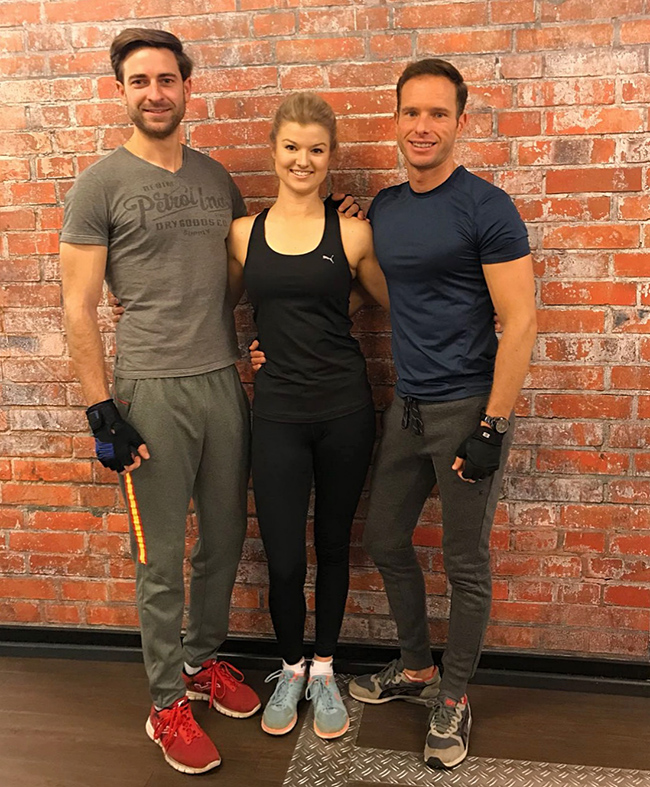
That’s why your riders in the team – Ashlea and Alex and Borja – go to the gym every day…
“They have to do this. They have to be in balance, they cannot have a problem with themselves because then they get unhappy while they are riding and become unfair to the horse. What I like about Borja is the way he deals with difficult horses – because we get many difficult horses here – the guy has an over-view, the good riders they always have things under control, he never gets upset, he knows what he has to do, and at the end he gets it.”
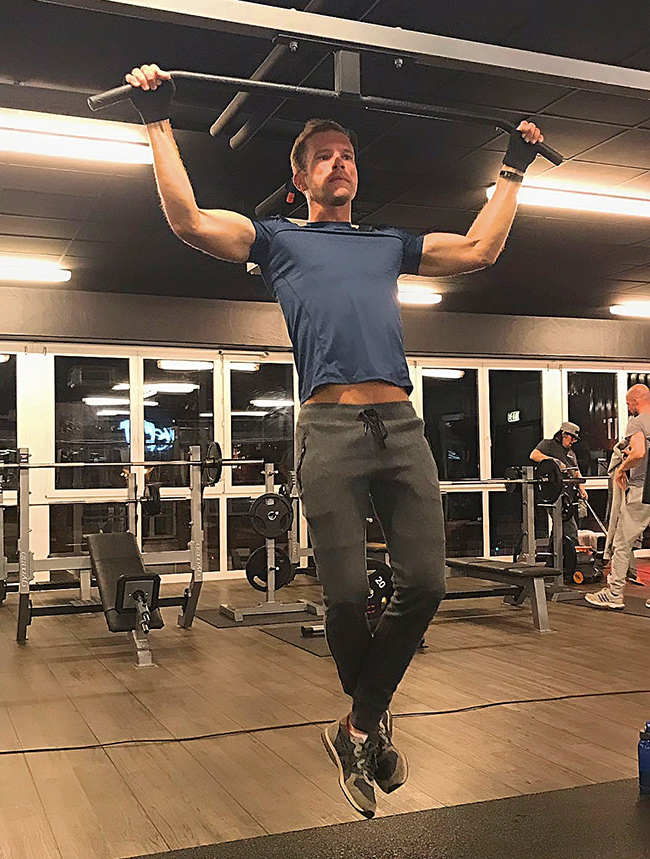
He tells me he has been working with you for a long time…
“He was thirteen or fourteen, I met him in Spain when I was training the Spanish team. Then he came to Germany and came for clinics in our stable, so we worked a long long time together. Then one day he decided he was coming to Germany to live, and he wanted to come and work with me, but I did not have room at the time. We were talking, what is the best thing? I said the best thing is you go to Mr Kasselmann, this is the best way to come further in your life. He went there for five, six years and this brought him a big step forward, because it is not only the riding, it’s how you manage a place. At a place like PSI there are so many people coming all the time, there are shows to organize, you learn to work. If you survive at Kasselmann, then you can do it. I think there is no better place in the world to go than to Mr Kasselmann, and Bianca, where everything is so family, but they ask 100%. If you come from there, you know what life is about.”
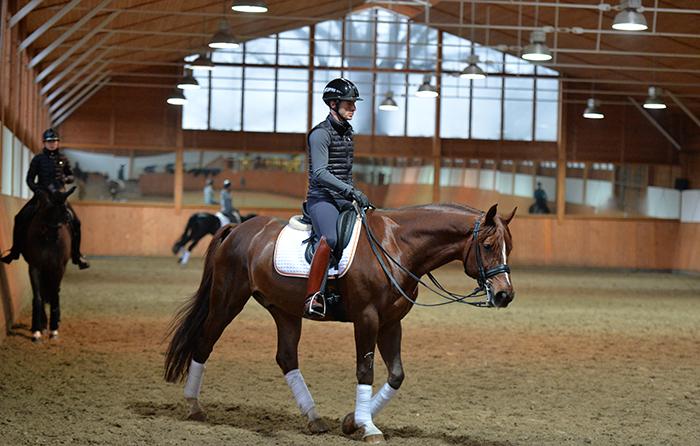
And the boys came along at just the right time, when you wanted to get rid of your stable…
“I didn’t want to have a stable any more because I have the job in France with their team, and when you are away the clients say, why should we pay money when you are not here? So I stopped it, and just at that time Borja rang me and said, ‘I am leaving Kasselmann, I had a super nice time, but now I need to do something else. I want to be not only in dealing, I want to be in proper riding. I want to have horses for myself, and I want to compete and I want to keep the horses and not just make them ready for sale.’ I said, well you go to the big towns, Munich or Hamburg, and you will always have customers. ‘No, no, no, I want to be where you are, and you have to help me.’ I said, let’s look for a stable, and we spoke with the owner here where I had been before. Can we rent again this place? Sure. The space was free so they rented it to us, then many of my customers from the old stables, came here, and so, like this, it starts.”
Borja doesn’t ride in a Spanish style, he rides in a correct, international style of good riding…
“Should there be any Spanish or French style? You have to ride good. If you are a good rider then there is no Spanish style or French style, it’s just good or bad.”
But really it comes down to the German way, the German principles, the German handbook…
“I believe in this German way of riding. When I was seventeen I went to Germany from Belgium. I’ve spent all my life in Germany. I worked for twenty years for the German Federation – I worked for many years in the school at Warendorf. I know the system by heart and I think it is the best system in the world. There is no better system. Everything starts from this system, and we don’t do today many things different from 40 years ago.”
“I came to Mr Schmidtke, he was my teacher. We were riding three, four, five-year-old horses, and we were only riding low and deep to stretch. One day I was riding the horse low and deep and he struggled and fell, and I broke my shoulder! But it was correct basic training, the way has to be. I am still grateful that I went with this man, Mr Schmidtke. Two things he said that I think are very important. He said, every horse can do Grand Prix. Even a donkey can do Grand Prix, but maybe a donkey is not a Totilas, because Totilas is born with more talent than a donkey, but also a donkey can do piaffe / passage. So every horse we had in the stable at that time, had to learn everything, that’s what we were paid for, that was our job. The other thing he said was, if you can do a Grand Prix, on a long rein, independent from the reins, then I know you have it 100%, and your horse is obedient and your horse is supple. The horse is in front of you, and then when you go in the ring, you put him up a little, and then you have the expression. But you cannot let him work with expression every single day, that is not possible. At a certain point the horse gets fed up, he doesn’t use his back any more, and he gets against you, and then you have to ask for more because he is against you!”
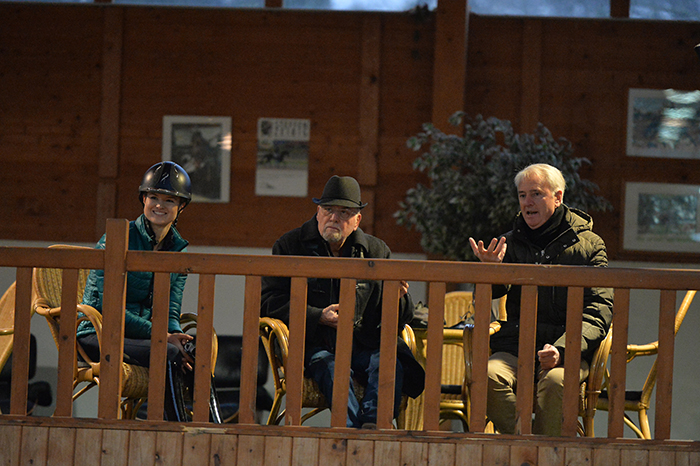
“At the end of the day, the horse has to give you success, you cannot take it. I am so happy that at one time I worked with Dr Schulten-Baumer, when he was a little older and finding it hard to work with his daughter. He said, Jean can you come and help? That for me was an honor, so I went two or three times a week and worked with his daughter, and then we went to the show together. There were so many good things he told me – and he was in the same way as Mr Schmidtke. All the horses have to go over the back, they have to go long and deep, the forwards has to be very good, they have to come, they have to go, like you want, you have to play with all these things.”
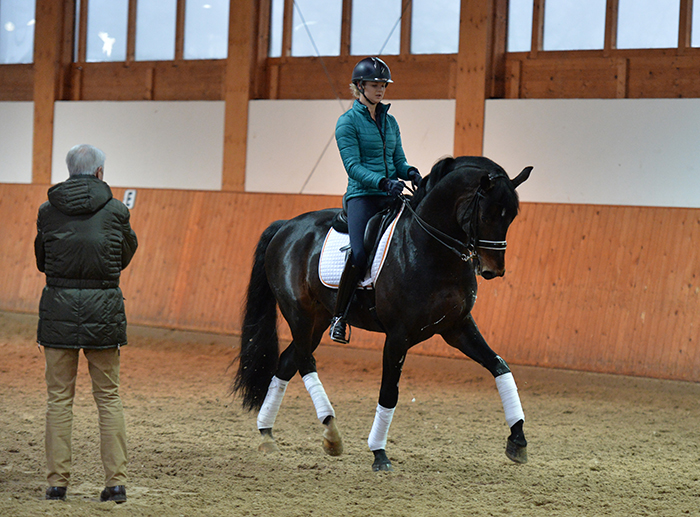
“Some people think that if you let the horse down low and long, then they cannot do exercises any more. No, no, no, it should be possible to go low and deep and make a half pass and you should be able to put the nose where-ever you want. This is nothing new, Harry Boldt told me this many years ago. I know I have said this before but – Who is a good rider? Not the one who can do piaffe / passage, you can take someone from the street, teach them ten lessons and if the horse can do passage / piaffe, he can do passage / piaffe. The good rider is the one who sits on the horse, and you tell him, I want the nose five centimetres down and now I want the nose ten centimetres further, now I want it up… If you can control the frame, to have the horse anywhere you want to have him, then you are a good rider, and then you don’t have any problems.”
And it doesn’t matter if the nose comes a little behind the vertical when you are starting…
“If you can bring it up again it is not a problem. I have nothing against it, because sometimes you sit on a horse and you don’t have contact. What do you do? The best is to do what you do if you are jumping and you know the horse is going to refuse, so ten metres before the jump, you drop the reins, and he refuses. No, what you do is take the rein, you hold him, you have contact, and he jumps. When we are riding it is the same, if you don’t have contact and you leave the rein long, long, long, then you never fix it. You have to find first a point of contact, and this can be, sometimes, a little bit round – but then you cannot stay there. You have to build up this contact in a forward movement. Many people when I say, let the nose go forward, bring your hands forward, they do it, and the nose stays where it is. You have to sit very independently, not hit him in the mouth, and then you can let him go, and you can say to the horse, please, please, you can go, stretch your neck, stretch your nose, you can go a bit longer, then you find again a point of contact, and maybe he comes a little short again, and you do it again. It’s something you can do every day over and over. You can’t do anything wrong this way. If you do, say 20 pirouettes, then maybe you damage him, but if you do 20 transitions, what can go wrong? Nothing – you just work on his gymnastic.”
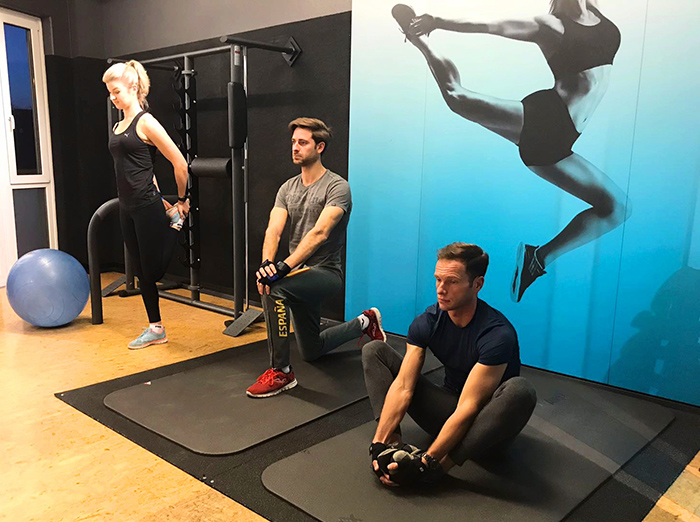
“Look at other sports, how much stretching they do. A football player is not just practising kicking a goal, he has to make his body ready. Personal fitness is very important, and if the rider has personal fitness, you have to give it to your horse too. That’s easy, sometimes it is a bit boring to just do transitions – come, go – but for me, I bought this mare, and I love to ride her and I love also to ride new exercises, like flying changes, but I also like to go on a straight line, make her trot big, make her trot a little bit slow, make it go forwards, make it go back, put her a little bit up, a little bit down, to play with her. These are my languages, my languages are my body, the contact, and we have a nice conversation together.”
“All this is not new. Many years ago I had to give some lectures and I was very nervous, oh I have to find out about new riding, tell things they didn’t know – no, just come back to the basic and try to have the easy things under control, and I think sometimes we forget it. If you see the good riders, like Hubertus Schmidt, it always looks good. If it looks good, it is good.”
And it is certainly looking good in the light, airy arena. There are riders from all over the world, Palestine, the Ukraine, Great Britain, and of course, our team of three.
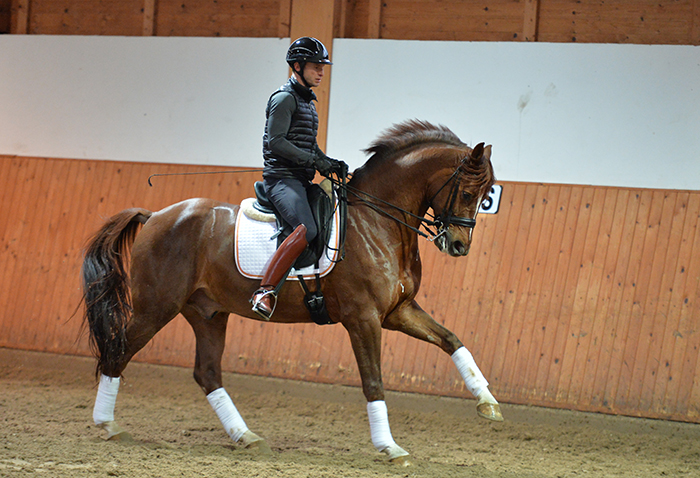
Borja is riding a flashy chesnut gelding…
“Borja’s horse is Ein Traum, eight years old by Estobar out of a Florestan mare. He belongs to a lady in Germany, a good friend of ours. He has already won Grand Prix with that horse.”
Borja comes from a traditional Spanish horse family, but one that moves with the times…
“My family they are breeding horses, Lusitano horses – we have a farm in Spain. We breed Lusitanos mixed with Dutch stallions over Spanish mares. My father, my grandfather, we are all with horses.”

The new Team in action at the Bundeschampionate in 2017, all concentration as Borja goes in for his test
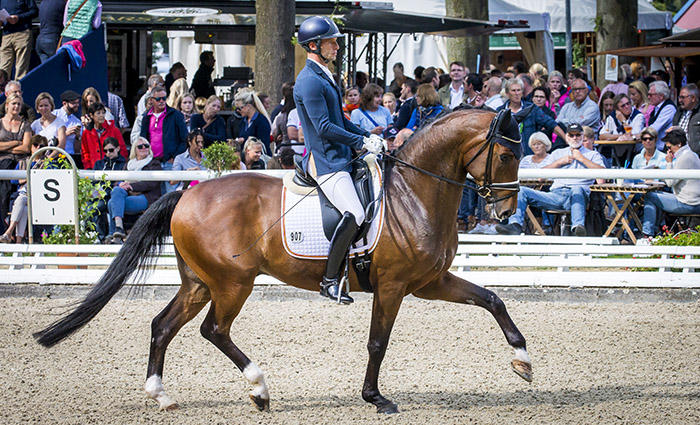
Up the centre line…
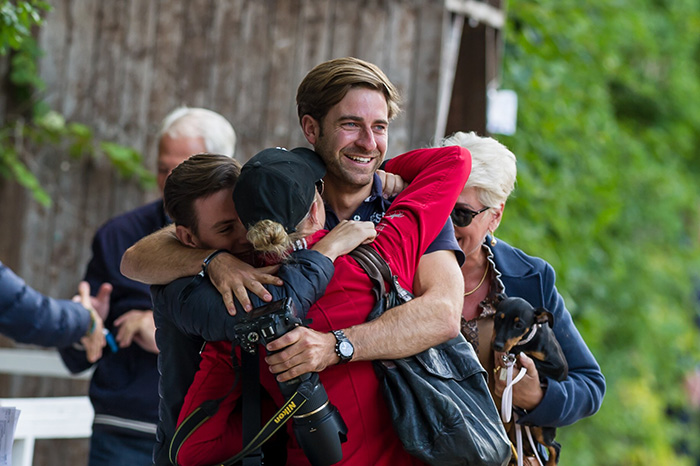
Great score for Runner-Up in the Championship, and the Team is delighted!
You met Jean when you were a young rider?
“I was a Junior, maybe fourteen. In this moment, Jean was the Spanish trainer, so we started to do clinics with him. We connected right from the first time. After some years I went to Germany to work with Jean for three months – he was also here in Krefeld, but in a different stable. After that I said, I would like to work with you and he told me about Kasselmann. Because in this moment, he said, I do not have enough horses for you to come to me. For sure if you go to Kasselmann you can have so many horses and go to so many different shows, and then, after some years, maybe we can do something together. But it is good for you to make a name here in Germany by starting at Kasselmann’s.”
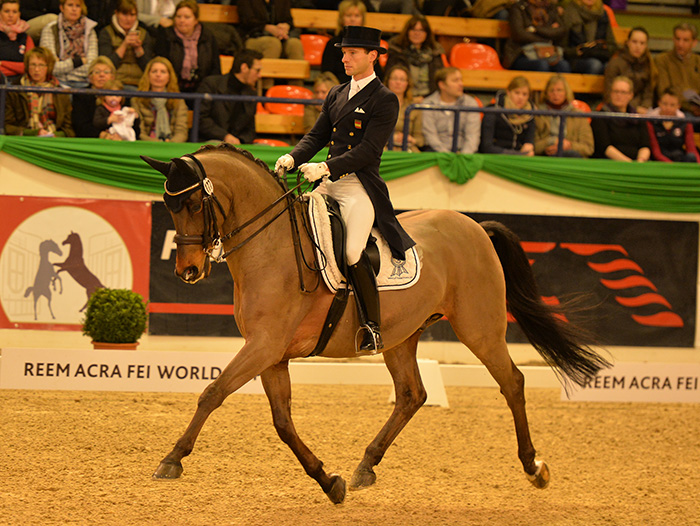
Borja competing at Grand Prix level for the Kasselmann stable
“Then I was at Kasselmann’s for five years, it was a great time, I got so much experience and they were super super nice to me. Then I talked again with Jean, and we decided to do something together. It was funny because he had just closed at the time a stable in Krefeld, but we found these stables nearby.”
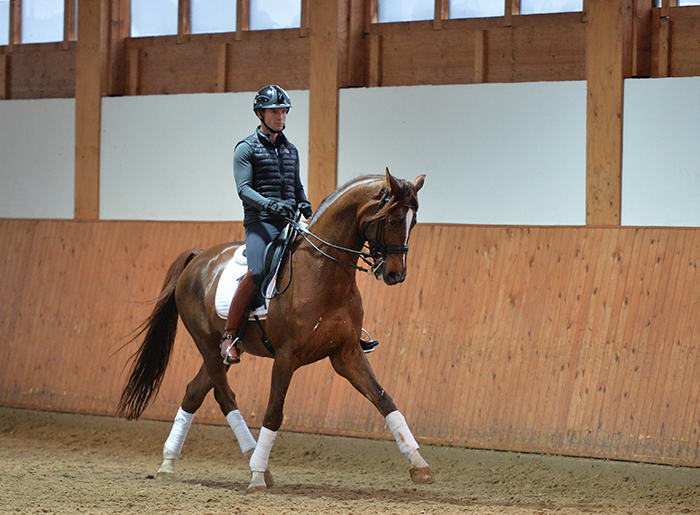
He is a great trainer, I think…
“Really good, I really like the system he has, because always it is about gymnastic with the horses, to make it really a sport for your horse. He is not just a good trainer for horses, he is really a good friend. I know he doesn’t like it when I say, you are like my father, he always says, I prefer your big brother, I’m not so old. But really I feel like he is my father, he helps me a lot, not just with horses but with my personal life. I know that if something happens, I can call him and he will always be there for me.”
Borja tells us about his prospects next
Tell me about the chestnut gelding you rode?
“He is eight years old, he came last summer and he came to fix the changes. I tried him, oh this is a nice horse and when the changes were good, he went home. Then he came back after two months, and we started training him every day. When he came he was competing Prix St Georges, Inter 1, but he has improved a lot and now we start with the passage / piaffe, and the changes. We did our first show at Inter 2 and Grand Prix, and he won the Grand Prix.”
I remark to Jean: Sometimes when Borja asks something, the horse switches his tail is this a problem?
“I don’t pay too much attention to this. This is sometimes a little bit of tension. This is a reaction to the leg – this anyway you cannot change. What you can do is ride with one hand and put the other behind the saddle…”
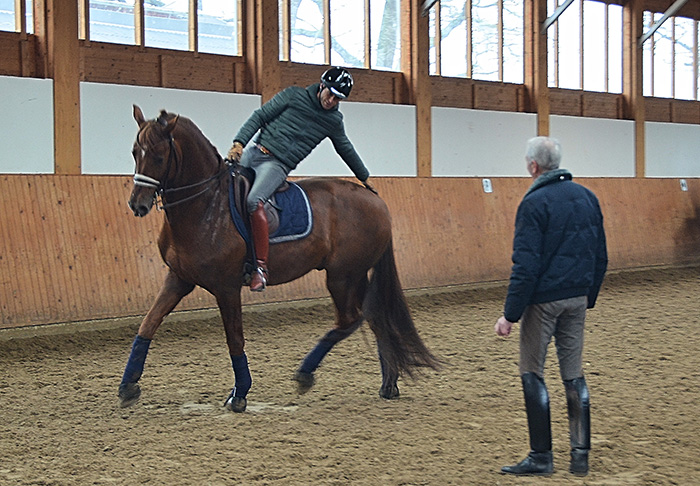
I’ve seen you do that – will it go away when the horse gets stronger?
“Maybe it goes away, but look for example now – it is perfect. Sometimes he has an over-reaction to the leg, and you can see it in the tail, okay you can be careful with your leg. It’s a minor problem, you must always see the difference between a minor problem that you can close your eyes a little bit, like for example, if they go in passage, just sometimes they make a double step, you can make the rider nervous with this, or you can just ignore it – but if they do it all the time, okay, that’s not a minor problem, it’s a big problem and you have to react to it.”
“This horse is only eight years old, and we have had him in training for three months here, so he is not so strong, but with the time and the training, he will get stronger and stronger and the thing with the tail will resolve itself.”
Jean is multi-skilling, I’m interviewing him, he’s still teaching Borja…
“Borja, sometimes in the transitions he is still a little bit strong. It always comes back on the same thing – he does all the exercises, but in the transitions, we have to go for perfection. That’s why in the transition from piaffe to passage, sometimes he struggles a little bit, this is why you should just touch him so he doesn’t stall himself in the piaffe, because then he goes in his comfort zone and then he doesn’t want to get out, then you have to push him out – he has to be the one that wants to go out, then you can follow him in the moment.”
“The horse is just starting his career, at the moment he lives from his talent, but now from the talent has to come the submission, then I think one day we’ll have a perfect horse. And if it is not this year, then maybe next year, we just have to give him the time to grow into this, so in the end he is coming in our direction and we don’t have to ask it all the time from him. At the end of the day, he has to come in our direction.”
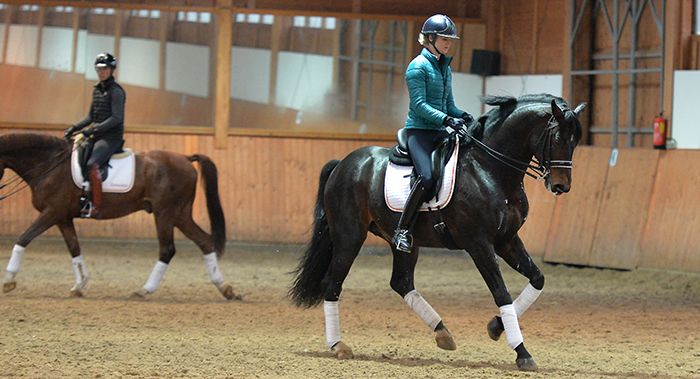
Tell me about the stallion Ashlea rode, the Polish horse…
“The Polish stallion, Arriba (9 years old, Alex x Roman Nature), is a beautiful type and he has a lot of talent with everything, but he is very quickly tired. In the last two weeks he has learned so many things, now he needs a break. He needs a holiday so everything he has learnt is absorbed before you put more on top.”
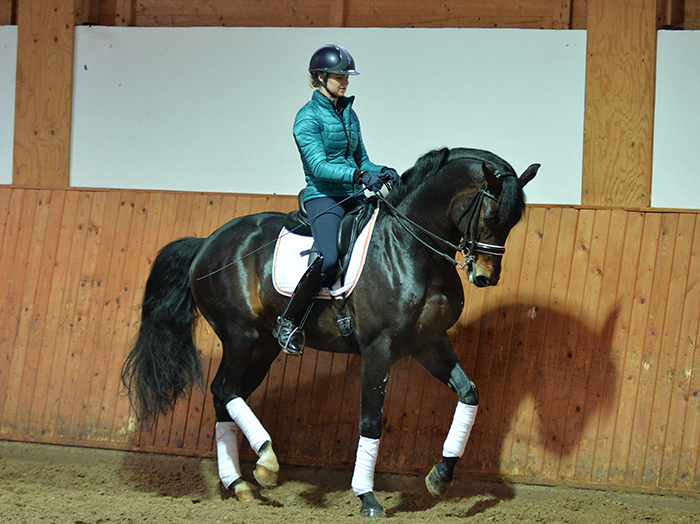
How did you find him?
“I did a clinic in Poland, and a girl was riding him there. I liked the horse and asked the owner what he wanted to do with the horse… Maybe I sell him one day. I said, I can’t bring customers all the way to Poland, and there are still things that need to be improved with the horse, why don’t you give him to us, and we will keep riding him, maybe compete him a little next year and in the meantime we have to see if someone comes and is interested in him, and we can sell him.”
Some nice Australian who will keep him for Ashlea to ride…
“This would be the best!”
Your team here all seems to fit together…
“Nothing lasts for life, but at the moment it works. We are very lucky that at the moment we have three grooms and three riders and they all understand each other very well.”
You were a little surprised when you found that your Australian groom was a rider?
“I knew that she could ride, but I didn’t know how good, then I saw her sitting on the horse, and she has very good balance. She can use her body and she can sit independent of the reins. She sits in the movement of the horse. With this basic you can work.”
Next we meet Australian rider, Ashlea Day
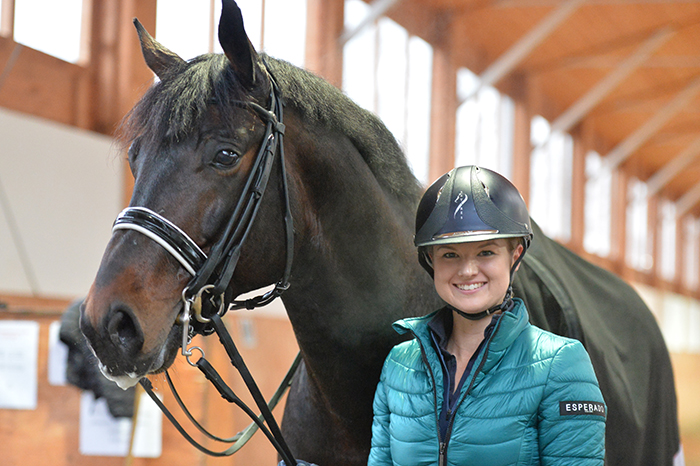
Ashlea is one of those people it is impossible not to like, she is so warm, so alive, so enthusiastic…
Did you go to sleep and wake up in dressage heaven one day?
“Here? Absolutely. It was a dream, my goal! This is really an incredible opportunity for me here.”
Let’s run quickly through the background story – you did all the normal showy, young rider things…
“I was big in the Young Riders dressage, really into that. Then I spent some time with Boyd and Silva Martin in the United States. That was a big step for me, moving country. Then I came to Germany to Frankfurt to represent Australia in the Young Rider World Cup final they used to have. That was a bit disappointing with my grey horse going lame, then colic surgeries and whatnot, but it pushed me to make the move to Germany. The competition in Frankfurt is so inspiring and amazing, it was a real eye opener.”
“I started in a little stable in Osnabrück. This was also a great experience for me. I rode a lot of horses. Did a lot of small shows, and really got into the swing of things. I was there for about three years, and then I felt that I really wanted to learn the system that I really came to Germany to learn, to really focus on.”
“So I rang Jean. He didn’t have a job for a rider, but he was looking for a groom. I’ll take it! You have to go for it, start where-ever you can. I came here and I was in awe. I was preparing horses, then able to walk the horses in the arena, watching everything I could. Sometimes that visual aspect really gives you the feel for the system. That was really a good way to start. At the time Jean was riding a five-year-old, and that was fascinating to see him sit on a younger horse, then an older horse, then to watch Borja as well. Watching the two work their horses, I was fascinated. Then I was lucky enough to get the opportunity to sit on a horse with Jean – and I was very nervous. I was terrified actually! This is my opportunity, now I’ve got to make it perfect. I think the nice thing was Jean sort of saw through that, and pushed me a bit to see where all the problems were, to show me things, teach me things. It had a really big impact on me. To be honest, I am in a situation where I am surrounded by incredible riders, great training and mentoring, my god, it gives me butterflies some times. I am very very grateful for this position.”
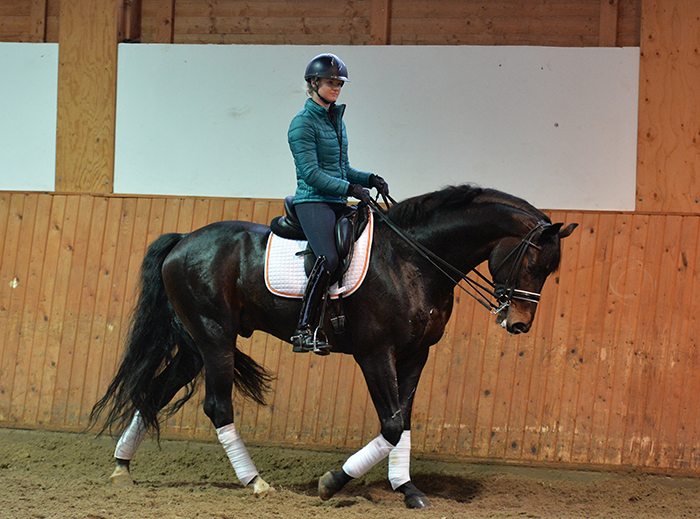
That looked like a pretty fancy horse you were sitting on…
“He is, HE IS! These little moments give me inspiration, he gives such an incredible feeling. It is also very good for me to sometimes sit on horses in the beginning when they come into the arena, then Jean and Borja will sit on them for a bit, and then I get on and sit on them at the end, and feel the difference. That also makes you appreciate the system and what we are working on every day. This horse in particular is very fancy for me, I like him a lot.”
“He is so comfortable to sit on, like a lounge chair, he’s a beautiful horse. I’ve been lucky enough to sit on quite a few since I’ve been here, and it gives you power.”
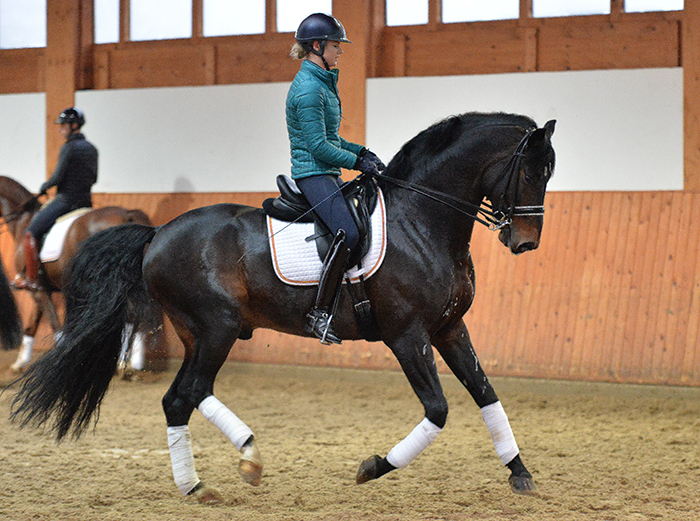
Jean was saying the horse had a few problems with his changes when he came here?
“Yes, I’ve been working on them with Jean and Borja, and they also sit on him, making the changes. I think a lot of the problem is, as Jean explained in the beginning, he really needed to work on the basics and get stronger, more in condition, and better balance. He really needs enough power to make the changes. Jean worked a lot on the basics with the horse, and it was really interesting to watch because the horse improved a lot.”
Jean kept saying to you before the changes – collect, collect, collect…
“It’s also good for me to have the feeling to really collect him and get his balance, and get him really on the hind leg, and Jean is right, I have to ride the changes more from behind, and this helps not only the horse, but me as well.”
I am quietly suggesting to Jean that it would be a great favor to Australian dressage if Ashlea could compete on Arriba.
“It is not so important for Ashlea to compete at the moment, the most important thing is the combination of all of us, riding all horses. Maybe I have some good things, then Borja has strong points where I’m not so good on, but then Ashlea is better looking than me, so everybody has their place.”

More information – www.iahp.com.au/australia/protexin or call 1800 801 201 (AUS) or 0800 424999 (NZ)
“When I started with Mr Schmidtke, I was also not competing at the beginning, I was learning, I was sitting on all the horses. Now it is very interesting because Ashlea can do a flying change if the horse can do a flying change. Okay, the horse comes to her, she asks for a change and the horse says, here you are. But we have some young horses that don’t know the changes, so you have to ride in a different way. You have to prepare him so he’s more or less ready, and then, oh that’s what you want! That’s different from when you ask, not necessarily at exactly the right moment, but the horse still says, here is a change.”
“That’s where it gets interesting because the big steps are always between five and six years old. The flying change is the first big issue. Counter canter, they all learn, shoulder in, half pass, they are all possible, but not every horse learns so quickly the flying changes. This is the first real difficulty. If they can do a good flying change to the left, and to the right, and they do it at the right moment, then this is already quick to go to tempi changes. But first of all they have to get this feeling of one change, and to have the right moment to ask for the change, to help the horse in this moment. The next step is the passage / piaffe.”
Ashlea’s horse was showing some good changes..
“But when he came here two weeks ago, he could not do a single change. Then sometimes we forget all the other things, and we do only this. In Spain they call this the five-minute education. For example, if you want to teach a horse, piaffe, you don’t ride him for an hour and then start on piaffe, when he is empty. Therefore it is better for a short time, maybe one week, that you get him out and you just do a little bit piaffe and put him away. Maybe you bring him out two times a day, it makes it more easy for him, because he knows what you want. Just do piaffe, and then you can forget it again, and go back to the other things.”
“It was very interesting to see yesterday that Borja for the first time was able to do fifteen one tempi changes. Today, the horse told me he needed a break, you have to leave him a few days, so it comes in his head – then after a break, we go back to single flying changes – because we destroy a bit the canter when we teach changes. Later when he knows what the change is, I go back for the quality of the canter.”
“That’s the most interesting thing in our job – you cannot say, that’s it, no, it’s every day different. I started riding my mare, Laponia 10 months ago – she is 10-year-old, by Stallone Quainton out of an Ehrenwort mare – and was teaching her the flying changes then the other day I got on her and felt, oh I did so many flying changes she is not right, so I stopped my idea of doing flying changes, and rode two days, no flying changes, then I feel, oh she feels happy again.”
“That’s very important to have the sensitivity to feel what the horse tells you. One of the biggest mistakes I ever made in my life, I had a super super good horse, it was at the time the most expensive horse ever bought at an auction. After I had this horse for a few years, he started winning at Grand Prix, but at that moment, he was not in good shape, he was coughing. Then the owner came one day and said, there is a very important show, and I want my horse to go there. I said, no the horse is not ready, we haven’t been training. ‘You have to go’, said the owner – I went and I killed the morale of my horse. It is important to feel where your horse is, and say, no, we don’t go to the show, we wait until the good moment is there again. Sometimes you keep pushing, but there should always be a reserve, there has to always be a feeling there’s more, never go to the very end, if you push him to where he is stressed, where he says, no, then going back is difficult.”
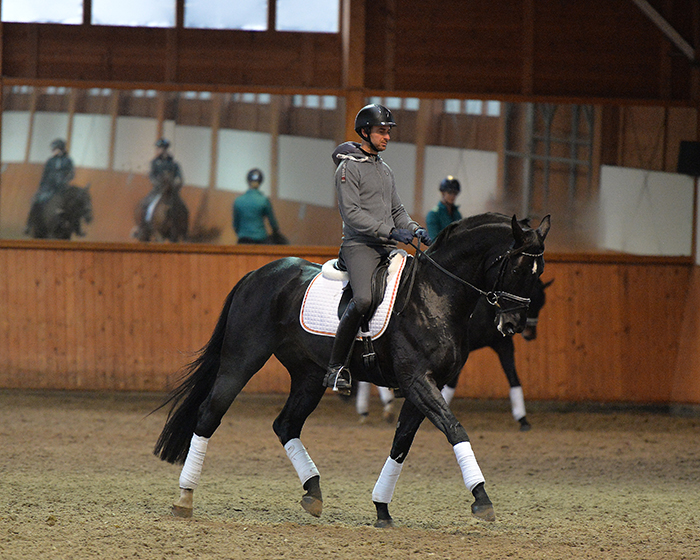
Alex, the multi-skilled organiser also rides…
Alex Brenninkmeijer gives off the air of knowing exactly what he wants to do, he’s the glue, the one with the big picture bringing a dream to a reality, but he has come from a tough school, where the Big Picture was very much front and centre.
So there you were events manager at PSI, a very prestigious job in a very prestigious place, and you decide to jump off the end of the cliff, and set up your own barn – when did that idea come to you?
“I am not from the dressage world. I started as a jumping rider when I was a kid. Then I quit riding because of my studies. Then I wanted to do something with horses so I came to Kasselmann and started with an internship, a bit of riding, a bit of office work, then it started to get more and more work in the office, more event management, more responsibilities, and in the end, after a few years, Borja and I just felt that it was time to move. I met Borja at PSI, I didn’t know him before, I didn’t know any dressage riders before.”
“Kasselmann was like the perfect gate opener to this whole world, it’s the place where you get to know everyone. I was lucky to organize the events not only at Hof Kasselmann, but also the shows in Ankum, and that’s how I met many of the riders. But after a few years, we felt it would be nice to do something on our own, Kasselmann is a top place to work for, but after a few years you may want to do something for yourself, something different. It is a lot of work. That’s when the idea came up of doing our own business, especially after Borja talked to Jean, and knowing that Jean would be part of it, he would always be behind us, give us advice, train us. Without him, we wouldn’t have done it.”
It is a unique skill set that you have managed to bring together – not to mention multi-ethnic, you all by yourself, are Dutch / Spanish / German…
“I am Dutch nationality, but born in Spain, raised in Spain, and went to a German school in Spain. Part of my university studies, I did in Germany. I’m just European, a bit of everything, but in my heart I am Spanish. Almost everyone in our team has a different nationality which makes it even more fun…”
And you got a bit lucky with your groom…
“Yes, a little bit. We were just about to leave for Rio and we were looking for a groom, not a rider. We didn’t have thirty horses then, more like fifteen, and with Borja, me and Jean, that was enough riders. Jean said, look, this Australian girl called me why don’t you talk to her, I already told her we don’t have a riding position. Ashlea started, when we went away for Rio, she was here and it all went very well. Soon she started warming up the horses, and we all said, oh she has talent, she rides well, so she can ride more, now she is part of our team.”
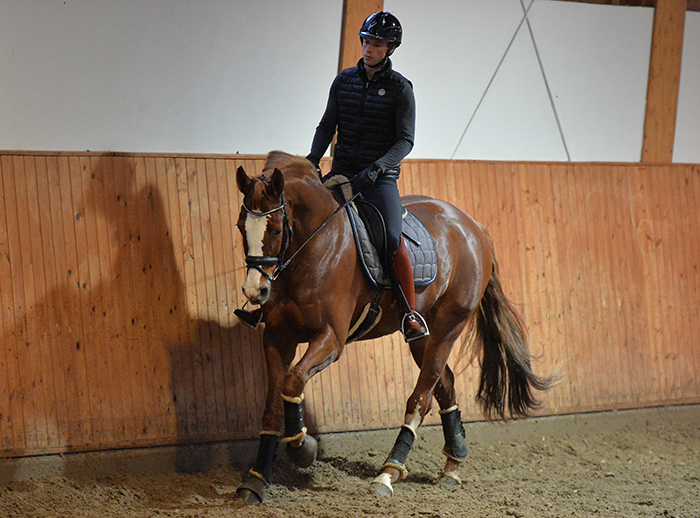
Borja has swapped the gelding for Laponia, Jean’s mare.
“This is a mare that I saw also in Poland,” Jean tells me. “She was in breeding and has had two foals, and she was a little bit complicated. She couldn’t canter. But I like her, it’s a nice type, it’s a beautiful horse and it has a quite good character, a little bit difficult character, but I like this. We bought her five months ago and she is already doing a little piaffe, the first flying changes, the other day I rode changes every three strides. She’s a nice prospect, we’ll see how far we come with it. It’s a game, we don’t need to prove anything, we just have fun and see how far we go.”
“You have to come back to the transitions because if you do too much work on the changes, then you lose the proper basic because you are so focused on the new exercise. Once the new exercise is understood by the horse, then you come back to the basic, to the proper canter stride.”
Apparently the new mare was a bit of a challenge for the team – not to fall off her!
“Not that she bucked, but she is so quick in the other direction, and then when you fall off, she says, aha, why are you not on my back any more? She is Ehrentusch on the mother’s side, and jumping blood on the father’s side. She can do fantastic transitions in the trot, she can come and go in a second. Look you shorten the reins and you cannot imagine the power she has. You see this now, but you should have seen it half a year ago.”
Who had to ride her then?
“Borja.” There is great merriment from Jean and Ash at the memory. “I looked a little bit from the ground. After a few weeks, Borja said to me ‘don’t you want to ride your horse?’ “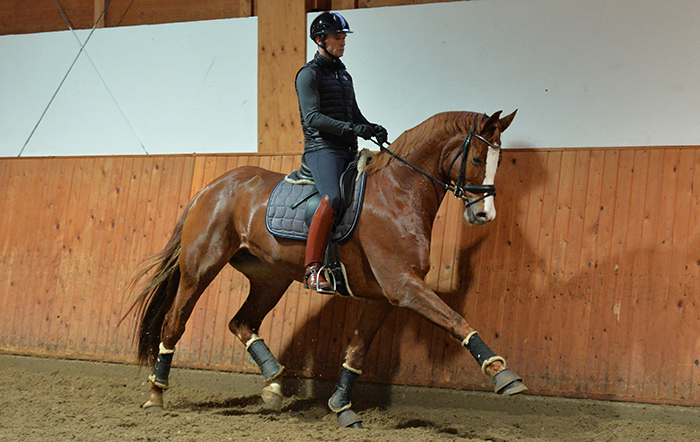
But it is Borja in the saddle for today’s session, to tell the truth, Jean has a terrible cold and is fading fast, it’s remarkable that he can teach and be interviewed simultaneously, but you get the feeling that a good rest in a nice warm bed is on the agenda. Meantime, he is still calling the shots for Borja:
“Okay now trot and play with the trot, big trot, little trot, this is what I love to do, play, you can have a thousand different kinds of trot. You can also see that at the beginning she trots a little bit sulky, there is no expression, just jogging – then the moment you sit, she has the point of gravity in another place and she starts to move very different. She is so strong, she is not only strong in the mind because she has a character we as riders cannot take away, but we have to win, she cannot think that she is the boss, we are the boss, and she is also strong in her body.”
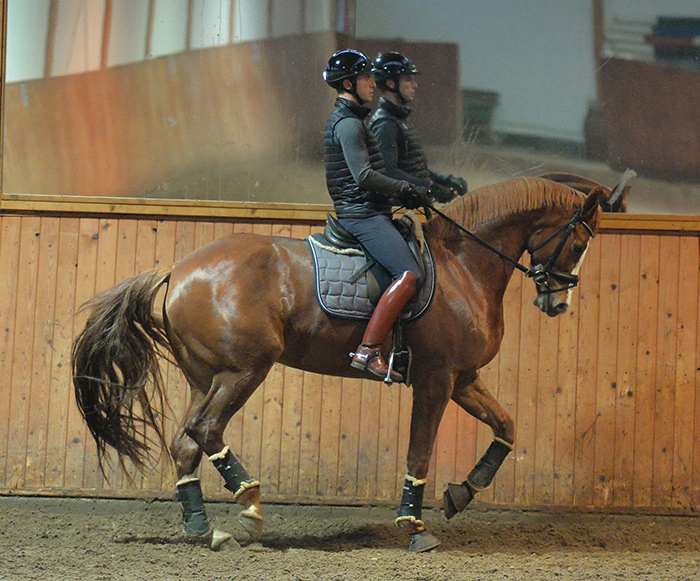
“Look how she can go and come back – super – and yet she could not trot at the beginning.”
“Now she walks and immediately super four beat walk, calm. She comes from power, to calm, in a second. And when you shorten the reins, she knows it is going to be piaffe…”
“You cannot imagine that six months ago this horse had nothing, you could not even make a counter canter, she could not hold it. It is so important for Ashlea, to see what you can do.”
Ash agrees: “And it has been such an interesting progression with this mare because between the three of us, we’ve all had the chance to feel how much she has changed, it’s incredible.”
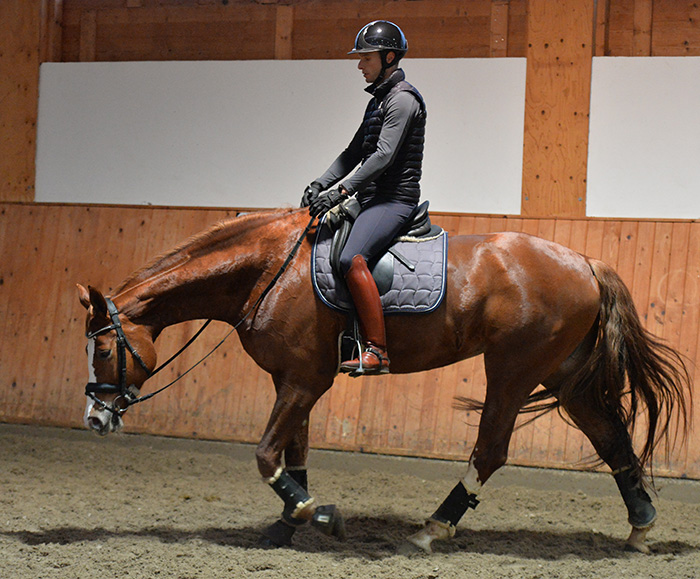
Jean is looking to the future for his mare: “With a little bit of imagination, you see the passage is coming. That will not be the problem. What is so nice, you sit on that horse, and you always have a horse in front of you. What is a good horse? A good horse is one that after being ridden for three quarters of an hour, you have the same feeling, the same power that you had in the beginning. Horses like that have quality.”
“The ideal situation would be if we could have only top horses, no customers, big sponsor who comes once a year, then we could do it all calm.”
“All my life, when I was competing, I always had a horse of my own. It was always very important to have my horse, that I can do whatever I want with. If I think I don’t need to ride, I don’t ride.”
“Look how good the changes are – you cannot imagine how it was even four weeks ago. And she is still in the learning process. Collect her, bring her on the hind leg, good so, that’s super good. Two weeks ago, we could not even think about this… If a mare is calm in the tail and looks like a stallion then they are always good mares. If I told you this is a stallion, you would believe me. She doesn’t look like a mare, and always the tail is quiet, even in the changes.”
“At the beginning Borja pushed for one change and it was not the right moment, and she does not react, she has to be ready, then the 8 is just the cream on top, but in the end, it is her, she wants to do it. This is something Ashlea is learning, to feel the moment when the horse is more or less ready to do it by himself. You prepare and she thinks, oh he wants a change, I’m ready, I’m ready. Now she knows the first changes and it is boring, we have to go passage / piaffe.”
“The two tempi, the one tempi, that’s a question of time. That’s not so exciting, what was exciting was to come on the diagonal and have one correct flying change, that was the exciting thing, but it is done now. The rest is just training.”
What do you do then after you get the gold medal?
“Go again. It’s very interesting, for Alex and Borja and Ashlea, they begin their life, but I have gone through all those stages, and I’m an observer, I like to observe. I look at people who are older than me, look at Harry Boldt, he is a super example for me. Early enough he stopped. I still feel I have the power, but the day I don’t have the power anymore, that I am just trying to keep going, time to stop like Harry.”
“It is very important that you live your life in certain stages, and you have to know, what can I do in this stage? Where am I happy in this stage?”
“I was competing super successful, but I stopped when I was forty seven. I didn’t compete any more. I said, there is another stage coming. It was a good decision, then as a trainer you have to learn to train. Okay, I can do a piaffe, I can work with horses, but training with people – how are they? How you convince them, how you get them on your side, that is also something that you have to learn. Then you have to learn to compromise, also with the horses. We have to compromise, otherwise we want to have this mare Grand Prix, next week. We need to compromise, we make a little break, and then we can go on, and then we can see.”
“As a trainer I have the same satisfaction I have as a rider. That’s why I respect Harry Boldt, many years I rode with Harry when he was in the A team. After Mr Schmidtke, Harry was my trainer, the one I had for the longest time. He was still competing, I remember competing against him in Berlin, and he was riding Zandokan in the Grand Prix. We were having dinner later, and he said to me, look Jean, competing, competing, I’ve got an offer from the German Federation to be the trainer, and that was my last competition. He stopped from one day to the next, then as a trainer he had super success for all those years. Then I saw him in Hong Kong, and he was training the Australian Three Day Eventers. But he was happy! He is happy with what he is doing. That’s how you should live your life, in good moments.”
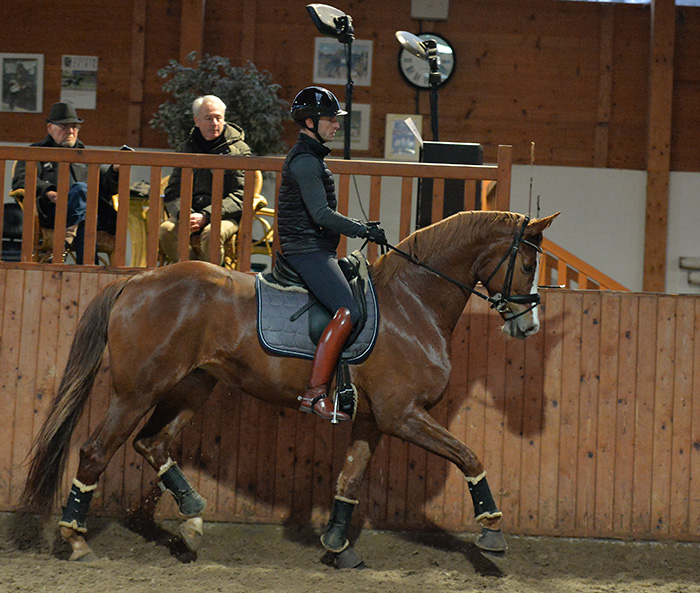
“Good horses and good students – and there are more horses to come. I cannot say too much but there is one super super horse in the pipeline. Wait and see.”
We certainly will, and thank you Alex, Borja, Ash and Jean for making this last story of our trip so very special…
Looking for an established star stallion to breed to? The latest new bloodline available in Australia? Go to www.ihb.com.au and see the amazing range of top European stallions
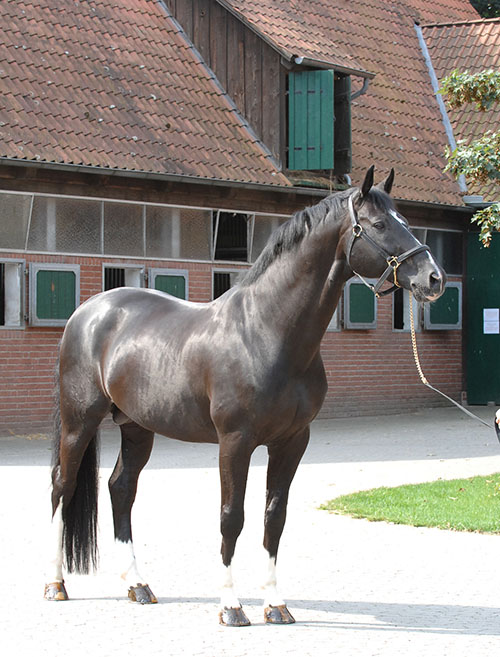
De Niro
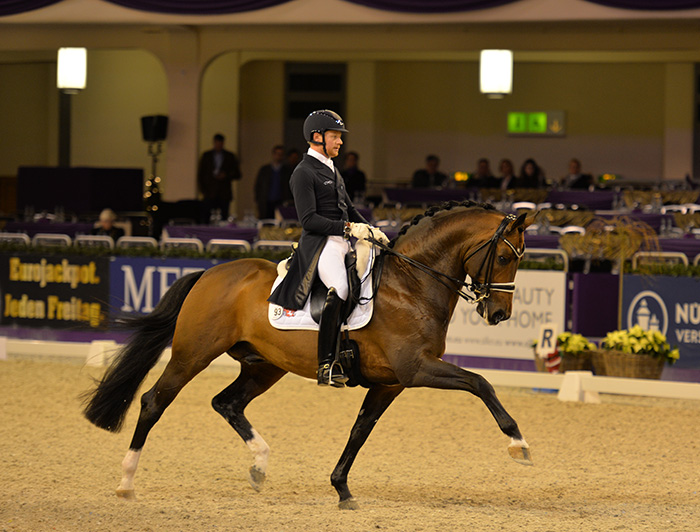
Foundation
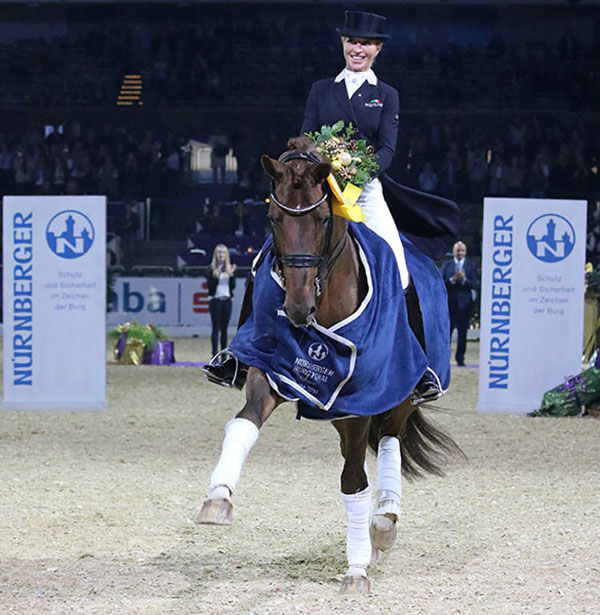
Vitalis


